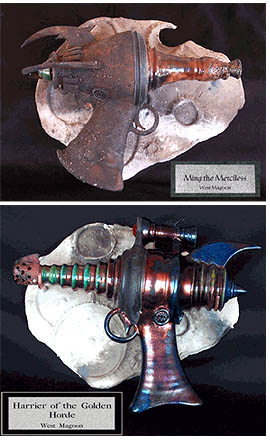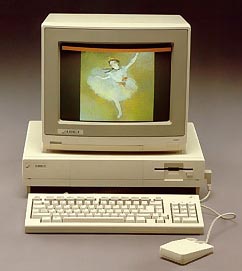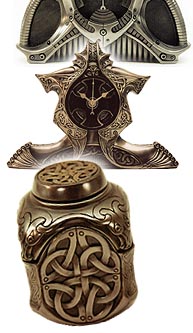
 West Magoon could be the name of a mysterious galactic cluster that emanates destructive varioplasmic rays, or – possibly – the moniker of an art deco city floating in the clouds over Edgar Rice Burroughs’ Barsoom. In fact, in a perfect world it would probably be both of those things.
West Magoon could be the name of a mysterious galactic cluster that emanates destructive varioplasmic rays, or – possibly – the moniker of an art deco city floating in the clouds over Edgar Rice Burroughs’ Barsoom. In fact, in a perfect world it would probably be both of those things.
In this imperfect one, though, it’s the name of a ceramicist in Wyoming who does lots of interesting work – none more interesting, though, than his one-of-a-kind series of ceramic ray guns with Raku glazes.
Each one of these ray guns is made individually from a series of parts turned on a potter’s wheel. They’re assembled and glazed, mounted, and named after science fiction authors or the characters from their stories. Every one is unique.
Shown here are the “Ming the Merciless” ray gun and the “Harrier of the Golden Horde” model. Each of these two has already sold as I write this, but there are many more to choose from – and he doesn’t seem to be done with them yet. At present there are two pages of these Raku blasters and an archive of those which have already gone on to arm their Omniscient Overlords. Of which, dear reader, you could be one.
This entry was posted on Wednesday, August 15th, 2007
and was filed under Found on the Web
There have been no responses »

 “A Summoner” is really just a brief scene, followed by clips that show off the modeling work that lies behind it. There’s a lovely storybook mood and style here and it feels quite painterly. It’s worlds away from the harder edged photorealistic work we generally expect from 3D rendering applications (here, Maya).
“A Summoner” is really just a brief scene, followed by clips that show off the modeling work that lies behind it. There’s a lovely storybook mood and style here and it feels quite painterly. It’s worlds away from the harder edged photorealistic work we generally expect from 3D rendering applications (here, Maya).
Warning: it loaded excruciatingly slowly for me. Go make some coffee or catch up on your email, have patience, and enjoy.
This entry was posted on Monday, August 13th, 2007
and was filed under Computer Graphics, Found on the Web
There have been no responses »
 The second article in Ars Technica’s History of the Amiga is now online; if you missed it, I mentioned Part 1 earlier.
The second article in Ars Technica’s History of the Amiga is now online; if you missed it, I mentioned Part 1 earlier.
This installment lays out the important groundwork for what became the Amiga computer and – notably – its custom chipset, which used coprocessors to handle graphics and sound in ways that were several years ahead of its time. In fact, the Amiga included some features that have yet to be duplicated. We see the addition of R. J. Mical to the Amiga team (though not yet, by name, other engineeers like Dale Luck and Carl Sassenrath) and we see how a timely slump in game console sales revealed the engineers’ hidden agenda: to create something that could be a game machine, but which was also the foundation of an advanced personal computer with groundbreaking multimedia capabilities. For once, their agenda and that of their backers converged.
This is probably not as fascinating as the last installment – or, I expect, the next – but if you’re not familiar with the background of the machine you’ll learn a good deal here that will be important in the next chapter. What we see is how the team transmogrified their project, kept it under wraps, and did the fundamental work that they still needed to implement in hardware.
This entry was posted on Monday, August 13th, 2007
and was filed under Computer Graphics
There have been no responses »
 I ran across this book (Subway Style: 100 Years of Architecture & Design in the New York City Subway
I ran across this book (Subway Style: 100 Years of Architecture & Design in the New York City Subway ) while I was looking for reference material for a long term project of mine. I’m especially interested in subway stations up to about 1940, but it’s difficult not to get sidetracked by the wealth of images and information in Garn’s book.
) while I was looking for reference material for a long term project of mine. I’m especially interested in subway stations up to about 1940, but it’s difficult not to get sidetracked by the wealth of images and information in Garn’s book.
 For example, who knew how interesting the evolution of turnstiles would be? And since these stations have been in constant use for up to a century or more, their layout and design has repeatedly been adapted to new systems for ticket-taking, seating, vending, and just about anything else that happens in a subway station… by design, anyhow. This may make the mainly modern photographs in the book problematic for me, but
For example, who knew how interesting the evolution of turnstiles would be? And since these stations have been in constant use for up to a century or more, their layout and design has repeatedly been adapted to new systems for ticket-taking, seating, vending, and just about anything else that happens in a subway station… by design, anyhow. This may make the mainly modern photographs in the book problematic for me, but  if anything it makes them even more interesting to explore. Still there are quite a lot of period photos and some great graphics used to advertise the subway and its destinations over the years.
if anything it makes them even more interesting to explore. Still there are quite a lot of period photos and some great graphics used to advertise the subway and its destinations over the years.
I could wish for more examples of mosaic and ceramic work, I guess – we do face the problem today that we can’t take our own reference photographs in the stations – but that’s due to the material I’m looking for. It’s certainly not a failure of the book itself.
At right is a detail I especially like – a modern addition to the Roosevelt Island Station, it uses forms that date back to a 1930 design in order to blend in with the existing fixtures of the IND line.
Here it is. Go forth and browse.
This entry was posted on Thursday, August 9th, 2007
and was filed under Reading / Watching / Consuming
There have been no responses »
 If you read my earlier blog entry you’ll have seen how my Saga Shirts site transmogrified over time from a site where I sold silk screened shirts to a print-on-demand based site – once I found a company that could do very good quality digital printing directly onto black and dark colored shirts. They’re Printfection, and they rock.
If you read my earlier blog entry you’ll have seen how my Saga Shirts site transmogrified over time from a site where I sold silk screened shirts to a print-on-demand based site – once I found a company that could do very good quality digital printing directly onto black and dark colored shirts. They’re Printfection, and they rock.
And as soon as I’d wrapped up the new Saga Shirts site, I wanted to use them with another kind of design that’s near and dear to me – my “Future That Never Was” of Retropolis, a land of personal rocket ships and Faithful Robot Companions – the sort of future that once seemed inevitable to us  because we were reading too many Buck Rogers comics and pulp magazines, reinforced by the fact that industrial designers were now streamlining everything – from locomotives and airplanes, where it makes sense, to clocks and refrigerators, where, just possibly, it doesn’t. I love that stuff. Especially when it doesn’t make sense.
because we were reading too many Buck Rogers comics and pulp magazines, reinforced by the fact that industrial designers were now streamlining everything – from locomotives and airplanes, where it makes sense, to clocks and refrigerators, where, just possibly, it doesn’t. I love that stuff. Especially when it doesn’t make sense.
(more…)
This entry was posted on Monday, August 6th, 2007
and was filed under Print On Demand, Works in Progress
There has been 1 Response »
 Blur Studio continues its progress from an in-game animation house through short films and, ultimately, to features with “A Gentleman’s Duel” – an eight minute 3D animated short in which a Frenchman and an Englishman vie for the superbly endowed favors of a noblewoman and, one assumes, her equally well endowed estate. It’s built like a brick mansion.
Blur Studio continues its progress from an in-game animation house through short films and, ultimately, to features with “A Gentleman’s Duel” – an eight minute 3D animated short in which a Frenchman and an Englishman vie for the superbly endowed favors of a noblewoman and, one assumes, her equally well endowed estate. It’s built like a brick mansion.
Matters quickly get out of control as they begin a duel in their Steampunk robotic combat suits. Mayhem ensues.
This short also marks Blur’s transition to Softimage software – they’ve long been a 3DS Max house – and the film became a testbed for their work with that software. It’s not 100% Softimage, but they’ve obviously done a fine job integrating Softimage into their pipeline.
This is Blur Studio‘s fifth ambitious short film. They’ve already collected one Oscar nomination for their earlier works.
This entry was posted on Sunday, August 5th, 2007
and was filed under Computer Graphics, Found on the Web
There have been no responses »
 |
My own combination of Celtic Art and Retro-Futuristic Design is such an unlikely mix that I don’t think it ever occurred to me that anyone else would try the same recipe – till I discovered the brilliant castings of Cornwall’s Design Clinic.They have an eclectic line of fifties style items inspired by autos of that period, some whiz-bang Buck Rogers retro-futurism, and a wide selection of Celtic art designs that range from clocks to boxes to skulls.
One of my own favorites is the chrome finished, car grill styled coat hooks set. But, as always, your mileage may vary.
|
 |
This entry was posted on Thursday, August 2nd, 2007
and was filed under Found on the Web
There have been 2 Responses »
 The Latin-literate technophiles at Ars Technica have posted the first installment in what looks to be a very complete history of the Amiga, which in 1985 was the most advanced graphics and sound computer on the market. The engineers who designed it and the software developers who supported it made the machine an ideal entry point into computer graphics for artists and animators.
The Latin-literate technophiles at Ars Technica have posted the first installment in what looks to be a very complete history of the Amiga, which in 1985 was the most advanced graphics and sound computer on the market. The engineers who designed it and the software developers who supported it made the machine an ideal entry point into computer graphics for artists and animators.
Anything I’ve managed to do with computer graphics is owed to those days and to those developers.
From the very outset the article concentrates on that central conflict between creative people and businessmen which was eventually to kill both the Amiga and the company that had purchased it, only to run it into the ground. It makes good reading.
This entry was posted on Wednesday, August 1st, 2007
and was filed under Computer Graphics
There have been no responses »

 West Magoon could be the name of a mysterious galactic cluster that emanates destructive varioplasmic rays, or – possibly – the moniker of an art deco city floating in the clouds over Edgar Rice Burroughs’ Barsoom. In fact, in a perfect world it would probably be both of those things.
West Magoon could be the name of a mysterious galactic cluster that emanates destructive varioplasmic rays, or – possibly – the moniker of an art deco city floating in the clouds over Edgar Rice Burroughs’ Barsoom. In fact, in a perfect world it would probably be both of those things.




















